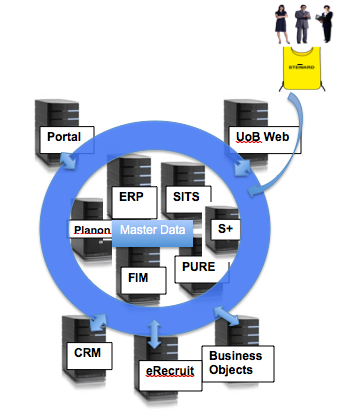This week saw a meeting of the University’s Data Governance Group. I gave a presentation about enterprise architecture, including my draft principles for data architecture and the need for governance of the data architecture as it evolves.
I requested that we produce a list of core data sets, with the data steward identified for each, and a standard process for requesting and recording access to data. Some of our data stewards already have reasonably mature processes in place, but others do not and the lack of standardisation makes it difficult for people to access the data they need.
We had a useful discussion about this and other issues. One key piece of feedback I took away was that my draft principles are focussed on centrally managed datasets, and I also need to consider how locally managed data fits into the architecture. The view of the group is that we need to ensure that this data can be managed without undue overhead. I think the tools we develop for documenting central data sets will also be useful for local data stewards, should they choose to use them, but we may require a level of governance for central data that would be optional for at least some local data.
I'm reminded of the "big blue ring" diagram that Nikki Rogers used to such good effect at the University of Bristol. I may well recast our informal high-level architecture diagram in a similar way. The following is the Bristol version:

The next meeting of the Data Governance Group will look into how the group should engage with various operational processes to better oversee the governance of data within the university. This should be a very interesting discussion.
I also had a meeting with our new Chief Information Security Officer, Alistair Fenemore. As Alistair has been in post for only a couple of weeks, this was very much an introductory meeting to explore our concerns and see where they overlapped. We agreed to meet regularly in order to coordinate our efforts and I look forward to working with Alistair.
I requested that we produce a list of core data sets, with the data steward identified for each, and a standard process for requesting and recording access to data. Some of our data stewards already have reasonably mature processes in place, but others do not and the lack of standardisation makes it difficult for people to access the data they need.
We had a useful discussion about this and other issues. One key piece of feedback I took away was that my draft principles are focussed on centrally managed datasets, and I also need to consider how locally managed data fits into the architecture. The view of the group is that we need to ensure that this data can be managed without undue overhead. I think the tools we develop for documenting central data sets will also be useful for local data stewards, should they choose to use them, but we may require a level of governance for central data that would be optional for at least some local data.
I'm reminded of the "big blue ring" diagram that Nikki Rogers used to such good effect at the University of Bristol. I may well recast our informal high-level architecture diagram in a similar way. The following is the Bristol version:

The next meeting of the Data Governance Group will look into how the group should engage with various operational processes to better oversee the governance of data within the university. This should be a very interesting discussion.
I also had a meeting with our new Chief Information Security Officer, Alistair Fenemore. As Alistair has been in post for only a couple of weeks, this was very much an introductory meeting to explore our concerns and see where they overlapped. We agreed to meet regularly in order to coordinate our efforts and I look forward to working with Alistair.
Comments